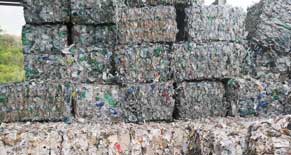Capital spending of US$300 bn for “Circular Plastics Economy” by 2050
Around US$1.5 trillion in investment by the global plastics industry would be required to meet growing demand for consumer plastics to 2050, and of this more than US$300 billion can be redirected to mechanical and chemical recycling processing capacity thereby meeting the goals of an aggressive circular economy case, according to research firm IHS Markit analysis.

Under current market trends, progress towards a circular economy for plastics would be modest, relying primarily on mechanical recycling. More ambitious goals, targeted at reducing the practices of landfill, incineration and energy recovery as end-of-life solutions for waste plastics may be achievable by redirecting a portion of new manufacturing investment towards a wider range of plastic recycling facilities, including both mechanical and chemical recycling, especially as the latter become more economically feasible.
The findings are part of the new IHS Markit Circular Plastics Service which provides a comprehensive, scenario-based road map of how the plastics value chain could transition from a linear to a circular economy. The research examines two scenarios: Progress toward achieving plastics circularity at an incremental, measured pace; and a more aggressive scenario in which progress is accelerated by ambitious goals and policies set by governments and society.
“Today, the plastics ecosystem has firmly committed to a transition in which the incumbent linear ‘make, use and dispose model’ for plastics is moving towards a more advanced state,’ says Robin Waters, executive director, plastics planning and analysis, IHS Markit. “In this new case, we keep resources in use as long as possible, extract the maximum value while in use, and then recover and regenerate valuable products and materials at the end of life.”
Driven by regulation, legislation and rising public concerns, progress toward a fully circular economy for plastics by 2050 is increasingly being sought. Yet, at the same time demand for plastics continues to grow as population and global standards of living rise. A large quantity of plastic is used in single-use packaging (SUP) applications and the vast majority of this plastic will ultimately turn up in the municipal solid waste (MSW) stream.
“Our analysis indicates that the situation is likely to become urgent,” says Anthony Palmer, vice president, IHS Markit. “At the heart of the matter is that the widespread benefits associated with the use of plastics contrast sharply with the way the world manages its end-of-life disposal—the so-called ‘Plastics Dilemma’.”
The global volume of municipal solid waste will increase from a level of 2.1 billion tonnes in 2020 to 3.5-3.7 billion tonnes in 2050. With plastics representing approximately 12% of this waste stream, this means global waste plastics will rise to over 425 million tonnes in 2050, an increase of 170 to 190 million tonnes.
“Most of this increase will occur in regions outside of North America, Western Europe and China—areas like Southeast Asia, India and Africa—owing to higher growth in population and standard of living”, says Palmer.
This presents formidable logistics issues that will challenge overall efforts to recover and recycle plastics, since these regions are quite distant from the manufacturing centers of plastics production associated with the current produce and export model.
“Recycle targets for the 2025 and 2030 timeframes—such as the EU Packaging Directive and the growing network of Plastic Pacts—indicate that society is tracking towards the more aggressive IHS Markit scenario, and industry will need to adapt its investments accordingly,” Palmer says.
At the current pace of progress, plastics recycling via mechanical processes could plateau at just 14% of plastics demand by 2050, or perhaps 22% under the more ambitious collection and recycling scenario identified by IHS Markit. The latter depends on significant advances in sorting, simplification of product design with end-of-life recycling in mind and development of Selective Solvent Dissolution-Precipitation technology to advance clean-up.
Under mechanical recycling, plastic recovered from post-consumer waste is separated via mechanical processes into a homogeneous plastic stream, cleaned and ground for re-use in new plastic articles.
Currently, this approach is the most advantageous from an economic, energy and carbon impact perspective. However, limitations to its use arise owing to some degradation during each re-use cycle, contamination by additives and other factors.
Therefore, although mechanical recycling is expected to increase significantly from some 20 million tonnes today to 112-200 million tonnes in 2050, for the base and aggressive scenarios, this process alone will not be sufficient to achieve ambitious circularity goals. Chemical recycling will be needed to close the gap.
Unlike mechanical recycling, which does not involve physical change to molecule structures, chemical recycling breaks down plastics waste via chemical and heat processes to result in a liquid or gas raw materials for use either as energy, or raw material for future polymer manufacturing.
IHS Markit expects step-change improvement in reactor design, catalysis and product processing to enable large scale implementation of chemical recycling, enabling the aggressive case scenario.
An issue to date has been one of scale.
“Technology advances would allow significant plant capacity scale-up, for example, from 500-3,000 metric tons per day, versus the 50-300 metric tons per day that are common today and where pyrolysis technology is cost-prohibitive,” says Jonny Goyal, associate director, technology and infrastructure, IHS Markit.
“Pyrolysis technology—that is high temperature processes—will be able to operate with improved economics and development and will demonstrate reductions in unit fixed costs by as much as 50-65%,” he continues.
IHS Markit believes that such advances along the so-called technology experience curve will enable total chemical recycling capacity to increase from just 1.2 million tonnes today to 44-190 million tonnes in 2050, for different scenarios modelled.
The IHS Markit analysis finds that closing the circularity gap will require global alignment of stakeholders:
- Governments and regulatory bodies need to coalesce and support the development of standardised goals and regulatory actions that provide clarity and promote a circular model for plastics.
- Consumers and alliances need to continue to support the move toward towards circular-packaging solutions and provide greater transparency, while recognising the many pressures companies face.
- Most importantly, industry will need to develop required technologies, build assets and manage costs in order to transition to a new circular model for plastics.
“The petrochemical industry’s core competency—turning raw materials into useful materials by chemical transformation—is being tested in new and profound ways,” says Waters. “Closing the circularity gap will require an unprecedented global alignment and adoption of actionable strategies including new business models, new alliances and logistics capabilities. Redirecting classical investments into new recycling efforts will be a critical part of this effort.”
(PRA)
Subscribe to Get the Latest Updates from PRA Please click here
©2021 Plastics and Rubber Asia. All rights reserved.

©2020 Plastics and Rubber Asia. All rights reserved.
Home Terms & Conditions Privacy Policy Webmail Site Map About Us

















